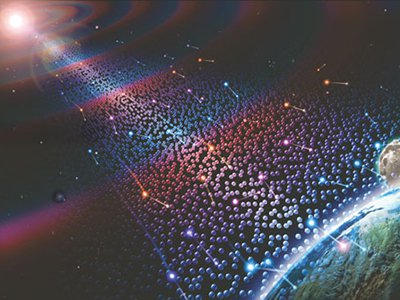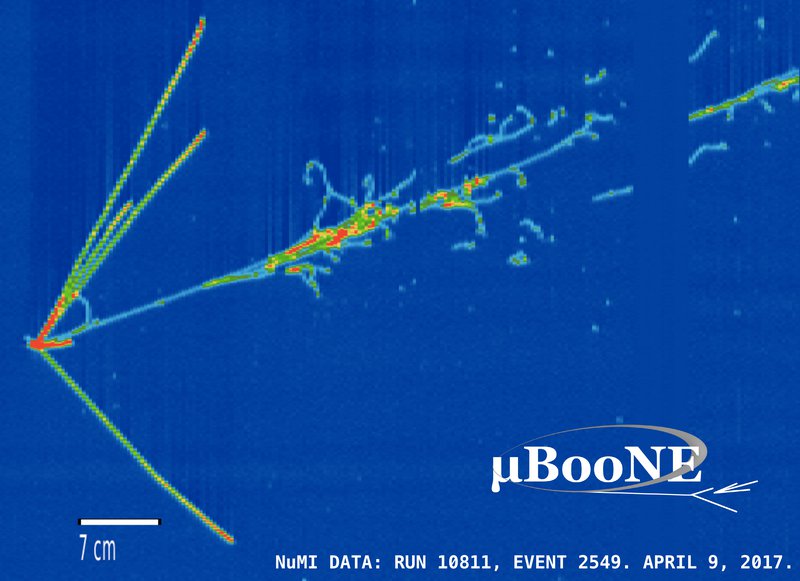Searching for the Universe’s Tiniest Clues
Thanks to grants from the National Science Foundation and the Department of Energy, A&S physicists Mitch Soderberg and Denver Whittington will continue their research at the cutting edge of neutrino discovery.

You may not know it, but every second 100 billion extremely tiny, invisible subatomic particles called neutrinos pass through every square centimeter of your hand. Syracuse University physicist Mitch Soderberg says the reason you didn’t notice is because they rarely interact with matter, so most of those neutrinos moving through your palm, and the entire Earth, come and go without a trace before zooming back off into the universe.
Neutrinos are produced by nuclear reactions and radioactive decay from sources all around us, including the sun, the atmosphere, nuclear reactors and particle accelerators.
“We know neutrinos and their antimatter versions, antineutrinos, would have been around in the early universe, and we want to know if subtle differences in the way they interact could have led to matter coming to be dominant over antimatter in the universe,” notes Soderberg, professor and associate chair of physics in the College of Arts and Sciences (A&S).
Nearly 14 billion years ago a tiny, dense, fiery region of space expanded and cooled to become the universe we know today, an event known as the Big Bang. The Big Bang should have created equal amounts of matter and antimatter, which are particles identical in almost every way except for their electrical charge. If that happened, the particles of matter and antimatter would have annihilated one another resulting in a universe containing nothing but leftover energy. Instead, a tiny portion of matter – about one particle per billion – managed to survive.
Understanding how neutrinos – one of the most fundamental, abundant and lightest subatomic particles with mass – interact may be the key to determining why our universe exists. By studying those interactions, Syracuse researchers hope to understand the answers to really big questions, such as why all of the “stuff” in the universe, including stars, planets and people, are made out of matter and not antimatter.

Enhancing Neutrino Detection
In collaboration with physicists around the world, Soderberg and members of his research group have played a key role in historic neutrino discoveries, including a groundbreaking study last year confirming no sign of a theorized fourth kind of neutrino (the Standard Model states there are three kinds of neutrinos—no more, no less).
Now, Soderberg will serve as principal investigator (PI) along with physics Professor Denver Whittington (Co-PI) on two new grants: one from the National Science Foundation and another from the Department of Energy (DOE) to study neutrinos and enhance future detection technology. Their DOE grant is part of the federal government’s $78M investment funding 58 research projects that will spur new discoveries in high energy physics.
Physicists analyze neutrinos using detectors such as MicroBooNE, a 170-ton experiment at Fermi National Accelerator Laboratory (Fermilab) in Batavia, Illinois. These detectors use cutting-edge technology to record 3D images of neutrino events. Inside Liquid Argon Time Projection Chambers (LArTPC), liquid argon serves as both the neutrinos’ target and the medium that transports the picture of the interaction to custom sensors and electronics that record the data.
“You get beautiful images of the aftermath of a neutrino smacking into an argon atom, which we use as the basis to reconstruct all the details of the interaction and learn about the properties of the instigating neutrino,” Soderberg says.

An image showing the aftermath of a neutrino interaction in the MicroBooNE LArTPC detector. The neutrino beam entered from the left, without leaving a trail, and one neutrino interacted with a single argon atom, creating a spray of other particles. (Courtesy of Fermilab)
The support from the NSF and DOE will allow Soderberg and Whittington’s group members to collaborate on neutrino experiments at Fermilab, which is one of the few places on Earth where a focused beam of neutrinos can be created and aimed at a detector. A group of researchers from Syracuse University are currently at Fermilab working directly on experiments with another team on the Syracuse University campus performing analysis and laboratory work.
Whittington, whose neutrino research is also supported by an NSF CAREER award, will use this round of NSF funding for his ongoing work with an experiment called “NOvA.” That project, which includes more than 260 scientists and engineers from 49 institutions in eight countries, is working to capture precision measurements on the behavior of neutrinos by sending a neutrino beam from Fermilab to a location in Minnesota.
“NOvA has already made world-leading measurements and is poised to make the first inroads into neutrino mysteries such as the fundamental differences between neutrinos and antineutrinos, which the Deep Underground Neutrino Experiment (DUNE) will ultimately investigate with next-generation precision,” says Whittington.
The research and development from these grants will play a crucial role in the DUNE project, which is expected to feature multiple LArTPCs each the size of the Physics Building, says Soderberg. The flagship international experiment hosted by Fermilab already has more than 1,000 researchers, including physicists from Syracuse University. DUNE will be located 1 mile underground in a former gold mine in South Dakota right in the path of a neutrino beam originating from Fermilab in Illinois. By sending neutrinos from Fermilab 800 miles (1,300 km) through the earth to detectors at the mile-deep Sanford Underground Research Facility, researchers will be able to make definitive determinations of neutrino properties, giving researchers insights into the workings of these fundamental particles.
According to Whittington, the funding will support their investigation of DUNE’s sensitivity to astrophysical neutrino sources like core-collapse supernovae, which are violent explosions that result from the rapid collapse of a star at the end of its life, giving birth to neutron stars and black holes.
“Should one occur in our half of the galaxy while the detectors are operating, collecting data on neutrinos from such an event would shed light onto the processes happening during neutron star and black hole formation,” says Whittington.
Sparking Student Discovery
Through the educational component of these grants, graduate and undergraduate students will work on everything from detector construction and operation at Fermilab and Syracuse, to the final data analysis and software development. “Neutrino experiments at Fermilab tend to operate 24/7 for years at a time, and our group members will take turns with collaborators from around the globe in monitoring the experiments, which nowadays we can do here at Syracuse even if the experiment is in Chicago,” says Soderberg. The team will also create an exhibit about particle physics to be displayed at the Museum of Science and Technology (MOST) in downtown Syracuse.
In addition, the coming year will also usher in a new era of discovery at Syracuse University, as campus will now be home to a prototype “pixel” LArTPC detector, developed by colleagues at Lawrence Berkeley National Laboratory and the University of Bern. Faculty and students will use the sophisticated detector to study cosmic rays, which like neutrinos, constantly pass through Earth going largely unnoticed. While harmless to humans or any other life on the planet, researchers have been unable to locate the source of these mysterious atom fragments that constantly rain down on the planet.
Students interested in engaging in hands-on, international research and exploring the secrets of neutrinos can learn more by visiting the Experimental Neutrino Physics group website.
Featured
Mitchell Soderberg Professor and Department Chair
Denver Whittington Associate Professor and Co-Director of Undergraduate Studies
